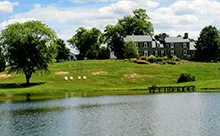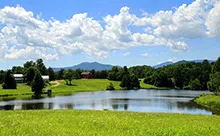Making Your High Elevation North Carolina Vineyard Profitable
While each of North Carolina’s climate regions fosters certain grape varieties, it can be more challenging for vineyards to produce consistently high quality yields in high elevations. Those interested in buying vineyards in areas with lower than average winter temperatures may be worried about disappointing crop yields. However, given the agricultural advancements that have put North Carolina wine on the map and careful management decisions, vineyards in traditionally difficult areas can be just as profitable as those in other areas of the state.
When considering buying land for grape growing in colder areas, winter minimum temperatures will be the most limiting factor when deciding which grape varieties can be grown consistently and profitably. While most wine produced across the globe is crafted from vitis vinifera cultivars (such as Cabernet Sauvignon, Chardonnay, and Merlot, to name a few), vinifera are among the least hardy bunch grape varieties.
As such, many popular wine grape varietals would be at a higher risk level for cold injury or death in North Carolina’s mountain region: most vitis vinifera varieties die when temperatures drop between -5 and -10 degrees, and can suffer wood damage when temperatures drop below 0. Merlot and Syrah, in particular, are susceptible to cold weather, making them poor choices in areas that may have late frosts or very low temperatures. Buyers should keep in mind that they may have to opt for hardier varieties in these areas rather than traditionally popular wine grapes.
While Cabernet franc is a vitis vinifera variety, it is slightly more resistant to cold weather than many related varieties. For areas in North Carolina with high elevations or cold winters, it is a safer choice than Cabernet Sauvignon, and tends to be much easier to grow. However, Cabernet franc should only be selected if the site has plenty of air drainage. Riesling is another more cold hardy vinifera varietal, but it most likely should not be selected for commercial vineyards because of its susceptibility to fruit rots in the summer heat and humidity characteristic of most areas of North Carolina.
Though Cabernet franc and Riesling are cold hardier than other vinifera varietals, North Carolina vineyards in high elevations find more success with hybrids and American grape varieties. These grapes can be resistant to winter temperatures from -10 to -25 degrees, depending on the variety, thus putting land owners’ minds at ease through even the worst winters in North Carolina’s mountains. The American varieties that have found the most success in high elevation areas in North Carolina are Niagra, Concord, Deleware, and Catawba. Each of these has been crafted into delicious (if less well known) wine in recent years.
While hybrids haven’t been widely planted in North Carolina, they have been proven to consistently grow high quality grapes with a high level of cold hardiness in other areas. Chambourcin, Seyval blanc, Vidal blanc, and Villard blanc have all been grown successfully in North Carolina, and there are several other varieties that show promise but haven’t been extensively tested. Most of the varieties suggested here and other varieties that might work well for a particular site can be found at eastern grapevine nurseries. (They will not be found at California grapevine nurseries, though, as these tend to carry mainly vinifera varietals.)




































